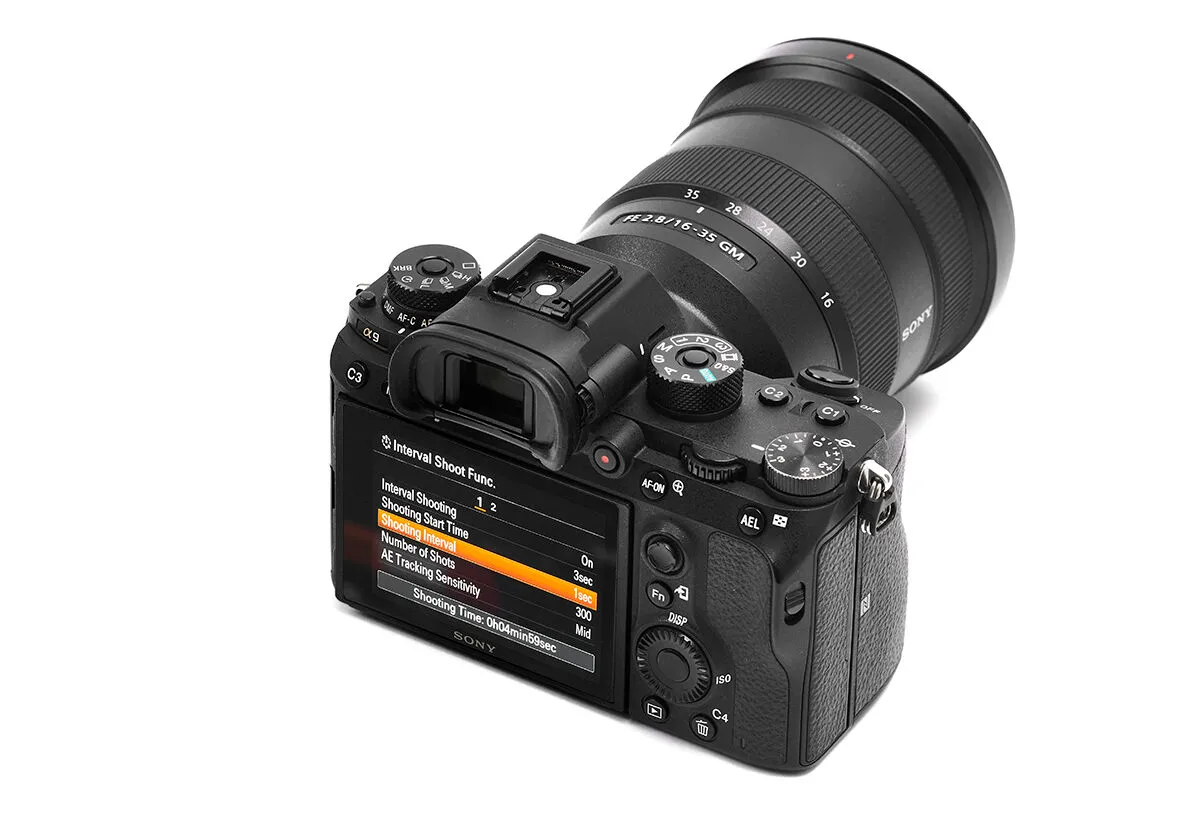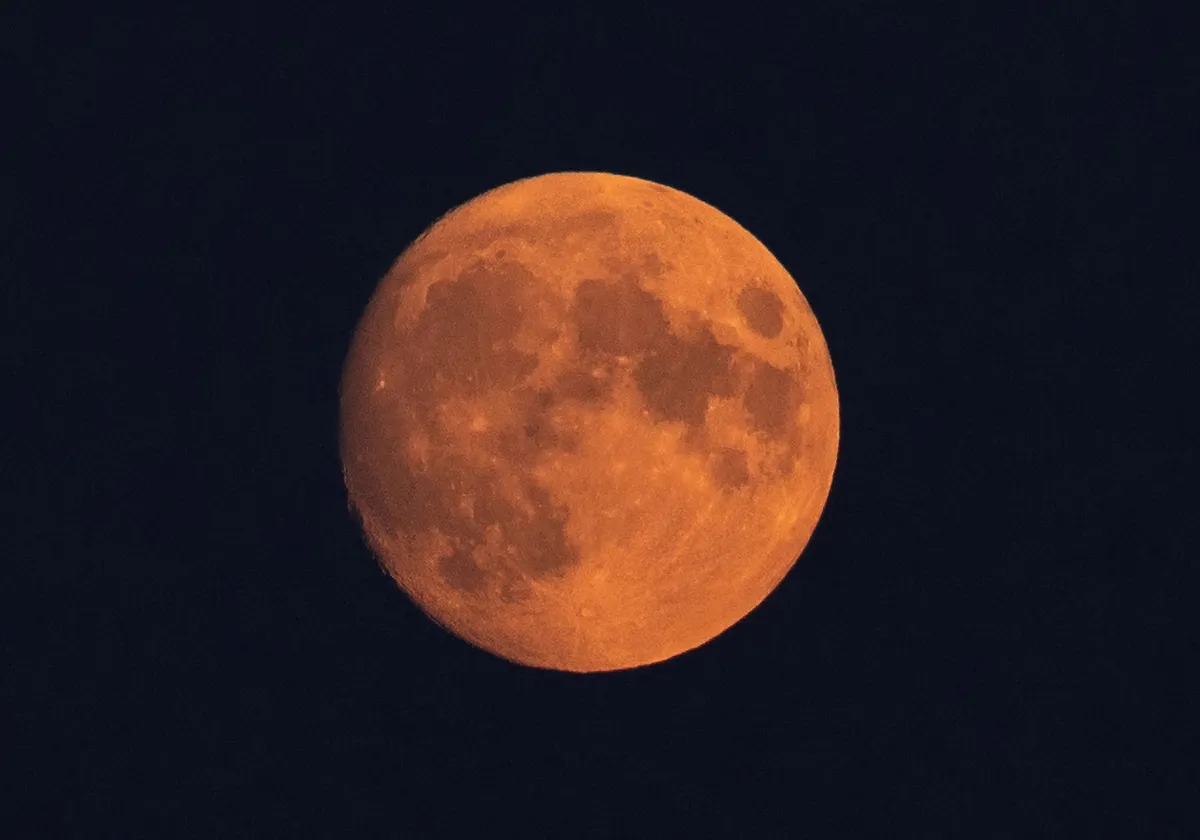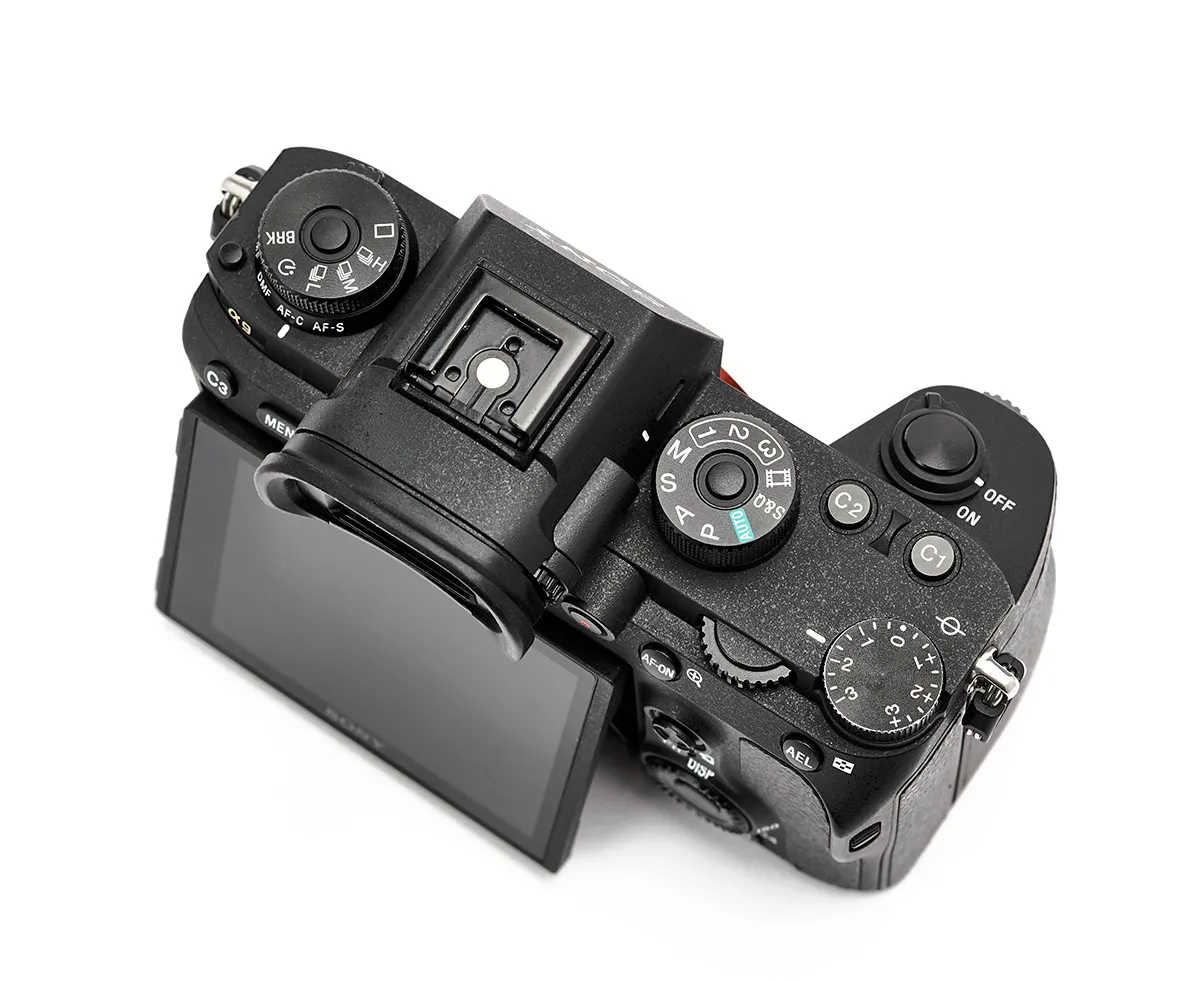Good things come in small packages, and when we opened the Sony Alpha 9 (A9) box we were surprised at how compact the enclosed camera body was, being about two-thirds the size of other full-frame cameras on the market.
Indeed, this is a camera we know we won’t have any issues with when we are balancing it with a long lens or small telescope.
The body fits nicely in the hand, while the control wheels – for changing ISO, exposure time and f/numbers – are very accessible and easy to locate by touch in the dark.
While such a compact camera is always desirable for astrophotography, we did however note that the gap between the grip and lens mount was quite small, which may pose an issue for larger hands.
Confused about camera stats? Read our guide on how to use a DSLR camera.

We liked the Sony A9’s four customisable ‘C’ buttons from the outset. These give the user a lot of flexibility when it comes to adapting the camera configuration.
The LCD screen is moveable, but not fully articulated. While we could pull out and tilt the screen at an angle, we couldn’t rotate it.
As clear summer skies beckoned, we headed out to put the Sony A9’s 24MP sensor through its paces with some Milky Way imaging.
The first thing we noticed while setting up was that the Sony A9 has a touchscreen – up to a point.
This camera is on our list of the best cameras for astrophotography.

We found that we could tap to set the focus point of our image, but we could not change the settings or take images via the LCD monitor.
This isn’t an issue if using an intervalometer (interval timer), or if the shutter button is sensitive.
Luckily, the A9 is very responsive, and even when we weren’t using a remote shutter release it didn’t pose an issue
Indeed, in lighter summer night skies, high ISO test images appeared clean.

Deep-sky views with the Sony A9
The Sony A9 really excelled when we used it to locate and focus on deep-sky objects.The ‘Live View’ was exceptional and sped up our setup time considerably.
While stars showed up easily on screen, we found the camera’s focusing was impressive.
By switching on ‘MF Assist’ (manual focus assist) in settings, it allowed the ‘Live View’ to automatically zoom in on our set focus point whenever we moved the focus ring on our lenses.
This avoids the hassle of finding a ‘Magnify’ button to press, which risks nudging the setup.
While we didn’t think the Sony A9 was particularly sensitive to Hydrogen-alpha (Ha) wavelengths, this may have been due to the seasonably light skies and a rising full Moon.
The Sony A9’s ‘Interval Shooting’ function is a game changer. It allows astrophotography newcomers the chance to try multiple long exposure deep-sky shots without the need for an intervalometer.
While the maximum exposure time is only 30 seconds in this mode, this is ample enough to do justice to many deep-sky objects and is certainly enough for Milky Way wide-field imaging.

Attaching a Sony A9 to a telescope
For those wishing to attach the Sony A9 to a telescope, it’s worth noting that a Sony E-mount T-ring is required, which is different to the standard A-mount T-ring many Sony cameras use.
An A- to E-mount adaptor is also available to purchase, which may come in handy for astrophotographers who are moving from cameras with crop sensors into Sony’s full-frame line.
While crop sensor lenses can be used – as long as the A9 is in crop sensor mode – there
are full-frame variants available up to 600mm.
Photographing the Moon
With the full Moon cutting our deep-sky object time short, we tested out the five-axis image-stabilisation by taking some handheld shots.
We were impressed, as we were able to keep the Moon central over several images and recover good details on the lunar surface later in post-processing.
The battery lasted across three nights of imaging before it needed charging, totalling about 4.5 hours.

For more advice, read our guide on how to photograph the Moon.
This is about the fastest, quietest ‘mirrorless DSLR’ we’ve tried – every long exposure, high ISO frame we took was read and processed with no ‘blackout’, meaning we were able to minimise the interval between shots.
Overall, the Sony A9 is an easy to navigate, enjoyable compact, full-frame camera with plenty of pleasing hidden extras.
It also transitions seamlessly from daytime to night-time photography.
Sony A9's full-frame sensor flexibility

Full-frame cameras generally offer greater ISO performance and sensitivity, meaning cleaner, noise-free images (with lower unwanted artefacts) in low light conditions.
Even when we were shooting at ISO 3200 in light, summer night skies we yielded impressively clean images from the A9.
The wider field of view that full-frame cameras provide makes them excellent nightscape and Milky Way devices. It also means we can use lenses at their true focal length.
The full frame (35.6mm x 23.8mm) Exmor RS 24MP CMOS sensor is a standout feature.
Designed to maximise the frame rate, the sensor is stacked onto a processor that optimises the sensor’s read-out time, which means the camera won’t lag between long exposure shots.
What’s more, the A9’s ‘Live View’ setting is among the best we’ve seen and it sped up our deep-sky setup process in challenging conditions.
The speedy processor also allows the A9 to show video at up to 100fps and makes the camera faster and more flexible for the user.
The A9 will excel in daytime photography and hold its own for nightscapes and for those wishing to indulge in a little deep-sky imaging too.

Sony A9: 5 outstanding features
1
Customisable buttons
The A9 body has four ‘C’ buttons that can be customised and programmed to the preferences of the user. This helps to make the camera even easier to use in low light. Simply programme these buttons to perform the functions you want and the camera is tuned to individual users.
2
4K video
The A9’s impressive 100fps maximum shooting speed comes in handy for lunar and planetary imaging, as it allows you to cut through atmospheric turbulence more effectively. In order to shoot in 4K, a memory card with a V30 rating must be used, as this has the write-speed capability needed.
3
Mirrorless design
Due to having no internal mirror the A9 is light to handle – and quiet. In fact, the ‘shutter sound’ that the A9 defaults to can be turned off, which allows you to shoot in complete silence at night. The A9 is as close to vibration-free as possible, which is a key attribute for an astro camera.
4
Adjustable LCD monitor
A moveable screen is always a bonus for DSLR astrophotography, especially when shooting deep-sky images. The LCD screen can easily be pulled out from the body and angled for more comfortable viewing. This helps if lining up a deep-sky object, focusing in ‘Live View’ or reviewing images.
5
In-built interval shooting
This is an excellent addition for newcomers to astrophotography who want to have a go without investing in additional kit such as an intervalometer. Located in the main menu, simply select how many frames to take and the exposure time (maximum 30 seconds) and the Sony A9 will fire off multiple images to stack.
Vital stats
- Price: £3,399
- Sensor: 35mm full frame (35.6mm x 23.8mm), Exmor RS CMOS sensor
- Megapixels: 24.2MP
- ISO range: 100–51,200, expandable to 204,800
- Live View: Magnify image 4.7x, 9.4x for manual focusing
- Lens mount: Sony E-mount
- Size: 126.9mm x 95.6mm x 63mm
- Weight:676g
- Supplier: Sony
- Tel: 0207 365 2810
- www.sony.co.uk
This review originally appeared in the October 2021 issue of BBC Sky at Night Magazine.
